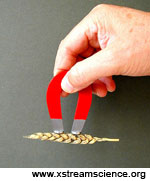
...english version below
NEUE STUDIEN ZU MAGNETISCHEN MATERIALIEN IN KORNKREISEN
von Nancy Talbott - BLT Research Team Inc.
In den vergangenen Jahren zeigten REM/EDX-Untersuchungen an Bodenproben aus Kornkreisen im Auftrag von BLT, dass es sich bei einem Teil des entdeckten magnetischen Materials möglicherweise um Rückstände von Flugasche und nicht, wie zuvor vermutet, um Eisenmaterial möglicherweise meteoritischen Ursprungs handelt. Flugasche ist ein Nebenprodukt kohlebefeuerter Industrieanlagen welches oft auch magnetisches Material in Form kleinster Sphären beinhaltet. BLT nimmt an, dass dieses Material – gerade zu Zeiten vor Abgaskontrollen- und Filtern – dieses Material weltweit verteilt wurde und dass dies es die magnetischen Rückstände in einer Reihe von Kornkreisen erklären könnte. Sollte dies sich zumindest in einigen Fällen bestätigen, so stellt sich jedoch weiterhin die Frage, wie es zu der nachgewiesenen Konzentration und Verteilung (zentrifugal und linear) innerhalb oder unmittelbar außerhalb der Kornkreisfläche kommen konnte, da sich Flugasche normalerweise ungleichmäßig niedersetzt. Eine neue Studie soll nun die bisherigen Daten erneut überprüfen und neue Fragestellungen erörtern. Die Ergebnisse werden unmittelbar nach Abschluss der Studie veröffentlicht.
(REM/EDX = Energiedispersive Röntgenmikroanalyse = Untersuchungen auf Gehalt u. Verteilung v. Elementen in Materialien Werkstoffen, Produkten oder Beschichtungen. Prüfung auf Kontamination mit Elementen z. Klärung v. Herstellungs- oder Verarbeitungsfehlern mittels energiedispersiver Röntgenmikroanalyse.)
Zudem bereitet John Burke, Co-Autor des 1995 veröffentlichten Articles „Semi Molten Meteoritic Iron Associated with a Crop Circle Formation“ (Journal for Scientific Exploration) eine Antwort auf die neusten Untersuchungen des sogenannten „H-Glaze“-Materials durch Rodney Ashby vor.
Ashby und Levengood/Burke berichteten unabhängig voneinadner über ihre Untersuchungen des 1993 in einer Formation bei Cherhill entdeckten glasurartigen Materials – kamen jedoch beide zu der Ansicht, dieses sei unter Beteiligung großer Hitze entstanden. In Rodney Ashby's aktuellen Überarbeitung wideruft er seine damalige Position aufgrund einer Probe, die er von den vermeintlichen Fälschern dieser Formation erhalten hat. Dabei soll es sich um Eisenpulver (und nicht wie ursprünglich behauptet um Eisenspäne) gehandelt haben. Nach Ansicht von Burke gibt es weiterhin Punkte die es zu diskutieren und zu klären gibt.
Wir informieren Sie natürlich über die Ergebnisse dieser Studien.
UPDATE 23.05.2005
Hier finden sie nun die obig beschriebene Antwort von Levengood Und Burke.
Für den Inhalt externer Links ist www.kornkreise-forschung.de nicht verantwortlich.
...english version
NEW STUDIES ON MAGNETIC MATERIALS IN CROP CIRCLE FORMATIONS
von Nancy Talbott - BLT Research Team Inc.
In recent years SEM/EDS examination of crop circle soils by BLT consultants has suggested that the magnetic material so frequently found in and near crop circles may - in many cases - be fly-ash, rather than meteoric iron as previously thought. Fly-ash is a by-product of coal-fired power plants which often contains micron-range spheres of magnetic material. BLT expects that, prior to the institution of modern emissions controls, this material could have been distributed widely over the earth's surface and may account for the presence of the magnetic spheres in at least some of the crop formations. If it is determined that the magnetic material IS (at least in some events) fly-ash, it will be the DISTRIBUTION of this material that will be of primary interest. Previous work has shown that the material is most often distributed at or just outside the perimeters of circular components of crop formations (indicating perhaps dispersal by centrifugal force), but it has also been found distributed linearly. Under normal conditions fly-ash (if present) would be expected to be distributed randomly. A new study is underway to re-evaluate this question and the results will be presented as soon as they are available.
(SEM-EDS = Energy Dispersive X-Ray Analysis = Investigations on the element distribution in materials and products by means of energy dispersive x-ray analysis (SEM-EDS), i.e. on the contamination with foreign materials and inclusions: For the detection i.e. of: penetration ability of foreign materials, the degree of purity of materials, the contamination of surfaces before the galvanic coating, the impurity, the reduced ability of adhesion of coatings etc.)
And John Burke, co-author of the 1995 paper "Semi-Molten Meteoric Iron Associated with a Crop Formation" (J. Sci. Exp.), is preparing a response to Rodney Ashby's re-evaluation of the "H-glaze" material found in a crop formation at Cherhill, England in 1993. Ashby and Levengood/Burke reported on this "H-glaze" material separately and, although their original conclusions differed somewhat, both examinations determined that heat had been part of the causative mechanism. Ashby's current re-evaluation recants this position based on a sample of iron powder (not the originally claimed „iron fillings“) claimed by hoaxers to be the original product and, additionally, does not deal with other points presented in the Levengood/Burke paper which need to be clarified.
You will be informed on further developments here.
UPDATE 23.05.2005
Click here for the above described response by Levengood and Burke